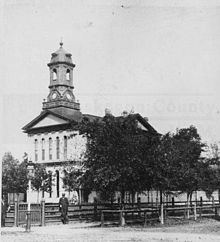Website www.co.muskegon.mi.us Founded 1859 Unemployment rate 5.1% (Apr 2015) | Area 3,779 km² Population 171,008 (2013) | |
 | ||
Points of interest Michigan's Adventure, Pere Marquette Beach, Milwaukee Clipper, Muskegon Lake, Muskegon State Park Destinations | ||
Muskegon County is a county located in the U.S. state of Michigan. As of 2014, the population was 172,344. The county seat is Muskegon.
Contents
- Map of Muskegon County MI USA
- History
- Geography
- Bodies of water
- National protected area
- Adjacent counties
- Demographics
- County government
- Elected officials
- State representation
- Education
- Historical markers
- Cities
- Villages
- Census designated places
- Unincorporated communities
- References
Map of Muskegon County, MI, USA
Muskegon County comprises the Muskegon, MI Metropolitan Statistical Area, which is part of the larger Grand Rapids-Wyoming-Muskegon, MI Combined Statistical Area. The White River flows through the county to its mouth at Lake Michigan.
History
Around 1812, Jean Baptiste Recollect and Pierre Constant set up trading posts in the area. By the Treaty of Washington (1836), Native Americans ceded parts of Michigan, including future Muskegon County, to the United States. This opened up the area to greater settlement by European Americans, who developed farms.
Muskegon County was organized in 1859. Its name is from the Muskegon River, which runs through it and empties into Muskegon Lake and subsequently flows into Lake Michigan. The word "Muskegon" comes from the Ojibwa/Chippewa word mashkig, meaning "marsh" or "swamp". See List of Michigan county name etymologies.
Geography
According to the U.S. Census Bureau, the county has a total area of 1,460 square miles (3,800 km2), of which 499 square miles (1,290 km2) is land and 961 square miles (2,490 km2) (66%) is water.
Bodies of water
National protected area
Adjacent counties
Demographics
As of the 2010 United States Census, there were 172,188 people residing in the county. 77.4% were non-Hispanic White, 14.6% Black or African American, 0.6% Asian, 0.9% Native American, and 2.5% of two or more races. 4.8% were Hispanic or Latino (of any race).
As of the census of 2000, there were 170,200 people, 63,330 households, and 44,267 families residing in the county. The population density was 334 people per square mile (129/km²). There were 68,556 housing units at an average density of 135 per square mile (52/km²). The racial makeup of the county was 81.25% White, 14.20% Black or African American, 0.82% Native American, 0.42% Asian, 0.01% Pacific Islander, 1.28% from other races, and 2.01% from two or more races. 3.53% of the population were Hispanic or Latino of any race. 17.2% were of German, 9.8% Dutch, 7.3% American, 7.2% English, 6.8% Irish and 5.5% Polish ancestry according to Census 2000. 95.9% spoke English and 2.6% Spanish as their first language.
There were 63,330 households out of which 34.60% had children under the age of 18 living with them, 51.60% were married couples living together, 13.90% had a female householder with no husband present, and 30.10% were non-families. 25.20% of all households were made up of individuals and 10.40% had someone living alone who was 65 years of age or older. The average household size was 2.59 and the average family size was 3.10.
In the county, the population was spread out with 27.50% under the age of 18, 8.70% from 18 to 24, 29.00% from 25 to 44, 21.90% from 45 to 64, and 12.90% who were 65 years of age or older. The median age was 36 years. For every 100 females there were 98.30 males. For every 100 females age 18 and over, there were 95.40 males.
The median income for a household in the county was $38,008, and the median income for a family was $45,710. Males had a median income of $35,952 versus $25,430 for females. The per capita income for the county was $17,967. About 8.80% of families and 11.40% of the population were below the poverty line, including 16.00% of those under age 18 and 8.20% of those age 65 or over.
County government
The county government operates the jail, maintains rural roads, operates the major local courts, keeps files of deeds and mortgages, maintains vital records, administers public health regulations, and participates with the state in the provision of welfare and other social services. The county board of commissioners controls the budget but has only limited authority to make laws or ordinances. In Michigan, most local government functions — police and fire, building and zoning, tax assessment, street maintenance, etc. — are the responsibility of individual cities and townships.
Elected officials
(information as of December 2014)
State representation
The Michigan Department of Corrections operates the Muskegon Correctional Facility in southeastern Muskegon. The prison first opened in 1974.
Education
Public School Districts in Muskegon County:
Private School Districts in Muskegon County:
Colleges and Universities:
Historical markers
There are twenty-three recognized historical markers in the county: They are:
